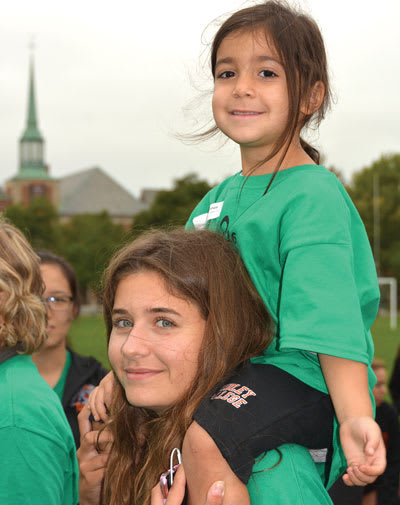Ridley College THE OUR KIDS REVIEW
The 50-page review of Ridley College, published as a book (in print and online), is part of our series of in-depth accounts of Canada's leading private schools. Insights were garnered by Our Kids editor visiting the school and interviewing students, parents, faculty and administrators.

Introduction
Throughout the campus, Ridley College presents like a classic English boarding school perhaps more than any other in Canada. It is set apart, which is one of the reasons it was founded in St. Catharines. The city, then as now, is big enough to have all the local support that is best to have close at hand—shopping, banks, transportation, a booming wine industry, quality health care—while being small enough to grant a cohesive on-campus community. In the 1880s, St. Catharines was proximate to the two major forms of transportation that were shaping the national character and economy: shipping via the expanded St. Lawrence Seaway, and a national railroad. Today, the primary transportation may take place over highways and airways, but the school remains at that sweet spot: close enough, but not too close.
There’s also a playfulness at Ridley that, if not apparent at first glance, nevertheless begins to reveal itself. The annual student achievement prize, for example, is called the Headmaster’s Zealous Achievement Award. It began under the direction of headmaster H.C. Griffith in 1935 and is given to one student each year at the discretion of the headmaster. It’s one piece in the long history of the culture of the school, which is both ordered and flexible, academic and active, and reverent and irreverent in amiable, appropriate ways. The school communicates well the benefits of effort and achievement, though it does so with an implicit awareness of the need for balance within the lives of the students and the faculty.
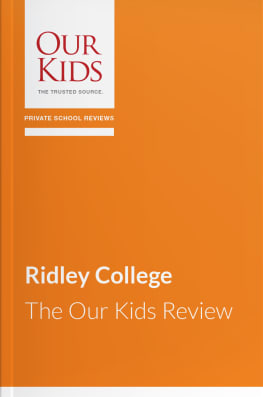
Key words for Ridley College: Tradition. Activity. Citizenship.
Basics
Although Ridley was once a boys’ boarding school, today it offers a coed, non-denominational liberal arts education to both day and boarding students. The Lower School comprises JK through Grade 8, and the Upper School comprises Grade 9 through a post-graduate year (after Grade 12). The student population is divided between the two schools, with a majority of students in the Upper School, and the majority of those within the boarding program. As such, this is a school defined by the culture of its boarding program, something of that benefits the entire student population, local day students, domestic boarding students, and international boarding students. There are a number of post-grad students on campus as well.
The buildings and the grounds are as comfortable, traditional, and habitable as you might ever hope to find. Coming through the gates, you feel like you’ve arrived at a place that’s ordered, welcoming, and safe—one with its own sense of time and set at a tangent to the world outside. And you have. The buildings are set around a green space, and if you have a chance to visit during the summer, you should. The grounds are impeccable, with circles of day campers sitting in the shade of stately trees eating snacks, playing games.
The Upper and Lower Schools bookend the main playing field, and when you see a photo of the campus, you typically see one of those two buildings. And rightly so—they are beautiful and contribute to the bucolic, pastoral feel of the property.
As with so many schools of a like age, the buildings on campus don’t date from the founding. The first buildings were destroyed by fire, leading to the reconstruction of the campus at its current location in 1903. Prior, the current property had served as the sports field, across the creek from the main campus. As a result, the oldest building on site is the cricket shed, which was in place before the move.
The offices are housed in the School House building, as is the dining hall and the library. There are classrooms on the second and third floors and along an adjoining wing. The adjacent Memorial Chapel was completed in 1921 to commemorate the 61 Ridleans who lost their lives in World War I. Ever since, the chapel has provided a cornerstone for the campus’s architecture as well as its culture. It’s as traditional as they come, and charmingly so. The main apse is augmented by a side hall, which was where women and girls used to sit, though it’s now welcome for all. Brass plaques are set asymmetrically along the walls, each commemorating a person who played an important role in the life and development of the school. The Lower School is centred in Alumni Hall. The façade is original, though the interior was updated in 2017.
Ridley was founded to reflect the Anglican tradition, and while the association remains apparent, there is no formal relationship with the church. Students sing hymns—“Jerusalem” is a favourite—and the iconography within the chapel reflects the precepts and the spirit of Anglicanism. Staff wear robes to chapel, though it reads more as a nod to academic traditions than religious observance. Prefect speeches are called homilies, though it’s a misnomer in the sense that they don’t present an exegesis of any religious text. Instead, they’re speeches on topics that the students choose for themselves in consultation with the faculty.
A cynical view might be that chapel is merely a continuation of a long-standing tradition simply because, well, it’s always been done. In practice, though, it’s an important aspect of school life, one that has been adapted subtly over the decades. It’s also an aspect of the school that students, by and large, appear to very genuinely appreciate. Meeting twice a week, chapel is seen principally as an opportunity to bring the school together, to restate its values and address issues and topics that are in the air. When we visited, the headmaster spoke about the Humboldt tragedy, and students lit candles of remembrance, offered perspective, and noted the various things the school was doing to mark the event and to generate financial support for the affected families.
The place of chapel within the program provides an analogue for other aspects of the school; at Ridley, these customs are managed through an adherence to tradition as well as the need to grow and innovate. There is a long history, evident in the roles, the uniforms, the division of the student body into houses, the participation in a cadet corps, and the events that dot the school calendar. That said, the school has continually developed, too, with administration taking time to reassess which traditions are retained, and how and why they are maintained.
A school’s alumni also exerts a force on its culture, and Ridley feels this very strongly, given the robust—and rightly welcome—involvement that many retain with the school. A strong alumni community is an asset in many ways, and Ridley’s is enviable. That sense of community is overtly apparent on campus, both in the dining hall—where all the chairs have names of past students—and elsewhere. There are some names that you see repeatedly on campus—Iggulden, Burgoyne, Gooderham—and more than a few have sent generations of students here. They, understandably, appreciate the traditions they’ve lived through, and they would like to see them maintained.
Something that has always been prominent at Ridley is an attention to values, though, there too, the school has made incremental steps over the course of decades to keep it relevant and appropriate to the needs of the current student population. The International Baccalaureate (IB) was adopted in 2012 out of a belief in the program and its merits, rather than as a means of improving standards above the provincial curricula. Michele Bett, head of the Upper School, explains that Ridley adopted the IB because it “spoke to our mission statement. There was this synergy, where both organizations want to do the same thing.” A basis in humanist values was certainly part of that synergy.
Leadership
Ridley has had just 10 headmasters in the 130 years since it was founded, with their terms averaging in excess of a decade. That’s impressive, and it’s significant of a consistent leadership pattern that has steered the school in its advancement. Ridley is forward looking and keen to address the needs of its current students, rather than simply upholding traditions. Still, that impulse is mediated and considered, with new practices adopted as appropriate and when in sympathy with the overall culture of the school.
The current headmaster, J. Edward Kidd, stepped into the role in 2012, moving into Kenyon Lett House (the headmaster’s residence) with his wife and three young children. He says that “education is almost in my DNA. My family is full of educators, [including] many generations of teachers, principals, superintendents, and professors.” Kidd grew up on a farm in the Ottawa Valley that was established by his great-great-grandfather in 1812. He counts farm labour as his first job. He was captain of the Queen’s University football team, and a member of the 1992 team (which won the Vanier Cup that year). He completed both a Bachelor of Arts and a Bachelor of Education degree at Queen’s, then a Masters of Science at the State University of New York at Buffalo. After teaching high school English literature in Canada, he taught in South Korea, eventually moving into the role of principal at the Shanghai American School in Shanghai, China. From there, he was recruited to Ridley. Upon his arrival, the IB program was adopted.
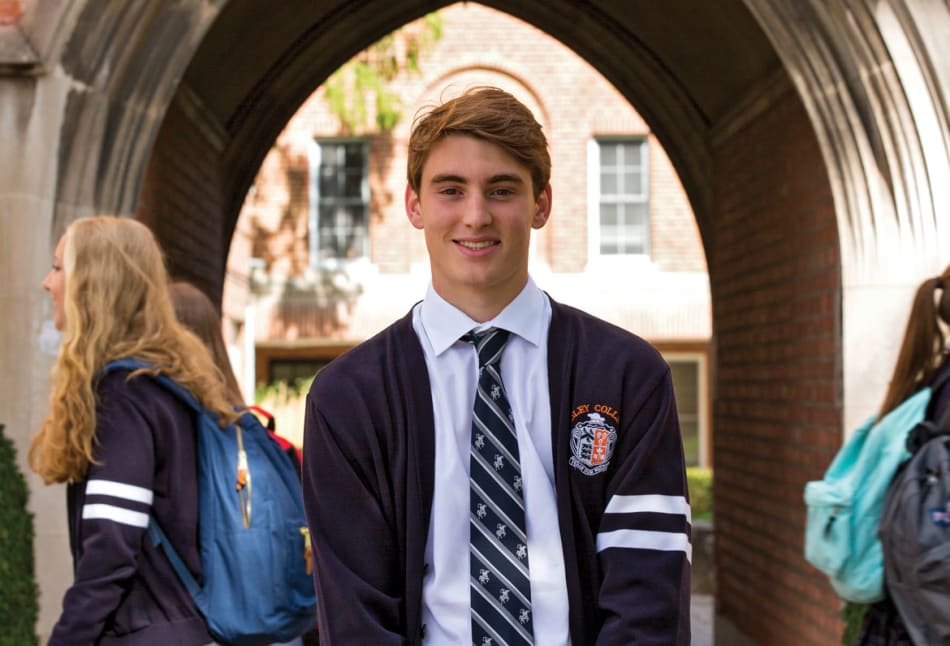
Background
On the morning of September 16, 1889, Tommy Nesbitt hitched up the horses, “adorned his whip with a festive ribbon of orange and black,” and set off to meet the boat carrying the first class of boys to attend their first day at Ridley College. But there was only one boy to meet him that day: Norman M. Trenholme, who became de facto Ridlean #1 (the students are still numbered today and entered into the official logbook held in the archives). Arriving at the school after a short trip up the bank and around the corner, Trenholme was greeted in the lobby of Springbank house by the entire staff, including the first house mother, Anna M. Cleghorn, and the janitor, remembered now only as Shakey. The staff gathered again later that day to welcome Ridlean #2, Walter G. Wood. And that was that. Such was opening day.
Ridley had been founded a year earlier by Reverend John O. Miller—he was there in the lobby that day, too. Miller’s intention was to reproduce “the best features of the best English schools.” St. Catharines was chosen as a location because of its proximity to a number of urban centres, including Toronto, Hamilton, and Buffalo, New York. The city was developed, in part due to the recent creation of the national railway (completed just four years prior) and the proximity to the St. Lawrence Seaway. Springbank Sanatorium had been built in 1865 as a spa retreat for wealthy industrialists, though attendance declined in favour of resorts on the eastern seaboard that were made reachable due to the newly developed rail service. When the Ridley board acquired the Springbank building, by default they also acquired Lieutenant Colonel George Thairs, who had been on staff at the spa. Thairs became the school’s first bursar and created the cadet corps. Known alternately as “The Colonel” and “The Captain,” Thairs remained a fixture of the school for the next 35 years.
The Reverend Mr. Armitage wrote that the founding staff “stood out in the annals of Canadian education, not only as marked by brilliancy and breadth of scholarship, but also as displaying the highest qualities of character.” They also stood out as being absolutely new to teaching. In that and so many other details, the stories of the humble early days are charming in how they contrast with the size and stature of the school now. The school colours—orange and black—were chosen because when Miller first saw Katherine, the woman he would marry, she was attending a tennis club gala in Toronto wearing an orange dress and a black net. A ribbon from the dress remains a part of the school’s archival collection.
Despite a slow opening day, more students arrived, and within a week’s time, the full first cohort of 48 boys was in place. “If there is one thing I should like to claim for Ridley College above all,” said Miller at the time, “it is that it is intended to be, and is, in touch with the spirit of the Canadian people, and of Canadian institutions.” Still, it was more a British school than a Canadian one at that time. The boys wore suits modelled on those worn at Eton. The majority were born in Britain, although there was one American—the school’s first international student—from Denver, Colorado. Nevertheless, Miller intended to build a sense of patriotism in his students, to encourage a drive for exploration, and to develop a lasting intellectual curiosity. And, as time would tell, he did.
Miller was himself remarkably young and active. There’s a photo of him training the gymnastics squad, and it’s hard to tell him from his students. In addition to a strong academic foundation, Miller hoped the boys would gain a healthy sense of adventure and be able to make something of themselves while bringing a bit of good to the country at the same time. The founding mission was drafted by Miller in 1888:
The only true education is that which develops the threefold nature of the child, symmetrically. First, the moral nature must be so trained and nurtured that it may develop according to the perfect design of the Creator, and that the child may at length become a Christian gentleman. Secondly, the intellectual nature must be trained and strengthened by continuous and judicious exercise so that the child may gradually grow into the condition of a mental athlete. Thirdly, the physical nature must be so cared for and developed, according to its strength and nervous energy, that the bodily temple may fit the spiritual organism that dwells therein.
The language is dated, but the core of the mission remains today: academics, values, and physical health. Bett has said that “times change, people change, but values don’t”—and it’s a sentiment that is shared throughout the faculty. The intention, in the past as now, is to prepare students for university and, ultimately, to flourish there and in professional life. Some of the old boys did indeed become titans of industry and finance, including two governors of the Bank of Canada. That said, there’s a nice breadth in the roster of alumni, including Humphrey Hume Wrong, ambassador to the United States and negotiator of the North Atlantic Treaty (which formed the basis for NATO). Peter Gzowski, a writer and broadcaster, fulfilled some of Miller’s initial goals in ways and on a magnitude that Miller couldn’t have fathomed. Through his radio programs, especially “Morningside,” Gzowski celebrated the country, shared its stories, and united its people literally from coast to coast.
“He was one of my favourite teachers,” says Wendy Darby (archivist, librarian, and alumna) of Richard Wright, who taught here from 1976 until his retirement in 2001. In addition to his career at the school, Wright was a novelist. He would be up at 4:30 in the morning to write before heading off to teach. He received international recognition for his work, earning the Giller Prize, the Governor General’s Award, and investment into the Order of Canada. Darby says that Wright had “a way with the students to explain writing in a way that made sense. He always used to talk about finding your voice. And it’s funny because now when I read his books, all I can hear is his voice reading it to me.” The legacy of Wright, and many others who have studied and taught here, contribute to the sense of place and possibility. His desk and his typewriter, a gift from his family, are now a part of school collections and sit within a room adjacent to the reception area.
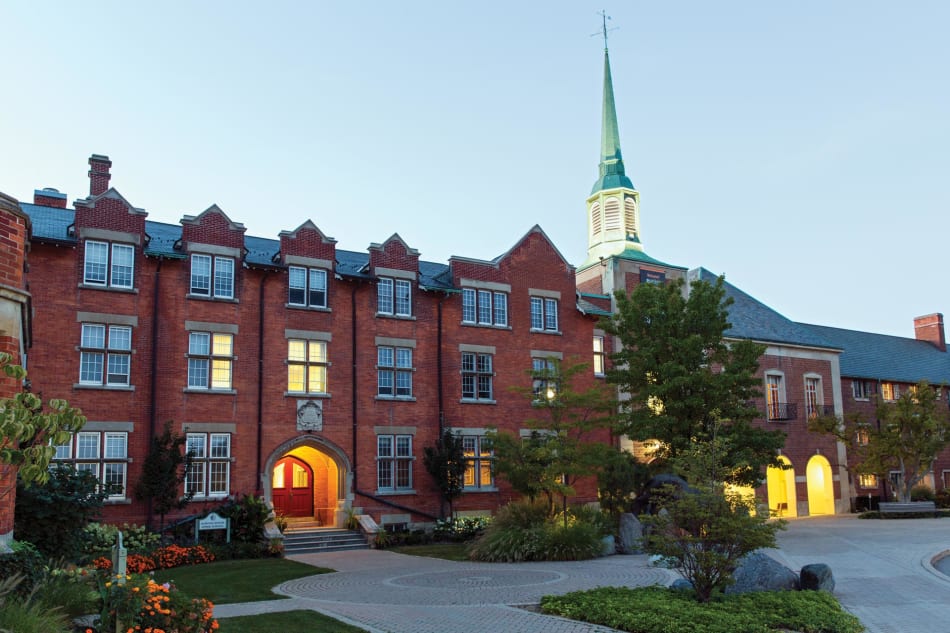
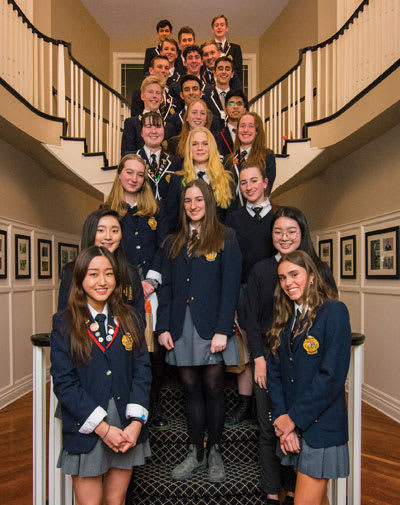
Academics
Ridley offers the Ontario Secondary School Diploma (OSSD) and the International Baccalaureate (IB). “The OSSD is recognized, and rightly so, because it is a robust curriculum with an agreed set of standards and a strong central philosophy,” says Bett, “so for us it’s a no brainer” to offer the IB alongside the OSSD, rather than in place of it. Ridley doesn’t offer Advanced Placement (AP) courses, and Bett adds “I’m glad we don’t” because “you can have too many things going on at the same time, too many competing programs.” The understanding is that AP courses would only serve to duplicate at best, and water down at worst, the opportunities that the IB curriculum already offers.
“They have a big package to offer,” one parent told us. “I like that they don’t have just the IB program, but also the mainstream academic offering.” All students graduate with an OSSD diploma—full IB diploma students will have an additional diploma granted by the IB—though the IB sets the tone of the academic program. Says Bett, “It’s calling on teachers to develop new skill sets. You know, that idea that a teacher is the font of all knowledge, the sage at the front of the classroom, and everybody sitting in rows—the IB is calling for a different approach. [It’s] more inquiry-based, more student-led.”
“IB is meant to teach students how to think,” says Kidd. “Rather than being a curriculum, IB is an approach to learning, a pedagogical philosophy that incorporates the best of 21st-century education.” A class learning about anatomy, for example, might be tasked with constructing a working model of a joint, gaining a knowledge of the structures involved through engaging with the task. “For us there’s this shift,” says Bett. “The teacher is the lead learner in the class. And there is an understanding now that you, as the teacher, will learn as much from your students as you hope they will learn from you—but they will also learn a great deal from each other.” Bett’s passion is evident. “I think it is the dawning of a new era for many of us, and I’m not supposing that we’re coming out of any dark age, or we’ve been getting it terribly wrong. But I think we’re open much more to feedback. Never in my lifetime have I seen research that’s happening around education move so rapidly to a classroom setting.” She’s happy to be a part of that, and to bring its benefits to the program she leads. “I would describe myself as the lead learner in the Upper School,” underscoring the collaborative approach that forms the basis for IB instruction.
Where some schools go all-in for a specific style of learning—discussion based, project based, didactic—Ridley has spaces appropriate to all. There are Harkness classrooms, including one with a classic table identical to those developed at Phillips Exeter Academy in the 1930s: oval, heavy, big, with pull-out boards for use when taking exams. But there are other classroom designs as well, including everything from static lab tables to modular tables and seating. The reason for the variety, says Bett, is because students learn differently, just as different activities benefit from different modes of engagement. “Sometimes you have an activity where you want to have three or four students working together in a group. And that Harkness table is pretty static.” Fair enough. So, while a few Harkness tables remain, other spaces have been outfitted with modular furniture. “We’ve heavily invested in this new furniture that you can, basically, do whatever you want with it. It’s portable, it’s malleable; different heights of chairs, different heights of tables. We’ve got the room surrounded in white boards.” Bett explains that it’s all created “to reflect new teaching practices. And if I needed convincing, I’m convinced this is the way forward.”
The defining feature of the academic environment, for many, is a sense of inclusion and participation in the life of the school, and the promotion of a diversity of perspectives. “What I appreciate most is the way that Ridley opened my mind from a very young age,” says graduate Cait Bermuhler. “Without it, my world would have been smaller. … As a Ridlean, you have this massive opportunity to seize—to be able to keep learning and growing and experiencing everything this big world has to offer.”
One parent told us that “the difference in my son, from an independence and a maturity point of view, has been phenomenal.” She notes that his time management and personal management skills have improved dramatically, as well as his perception of himself and the world: “He’s more worldly.”
“I have a lot of favourite teachers [from Ridley],” an alumnus told us. “They go above and beyond, creating a safe place for you to learn, and pushing you beyond what you think you’re able to do.”
Lower School
Ridley is one of relatively few schools of its kind that offer the full IB continuum, including the Primary Years Programme (PYP) and the Middle Years Programme (MYP). They were both created to support entry into the secondary IB program, or Diploma Program (DP), and as such instruction is modelled in similar ways. Class work is challenging, though it takes place within a culture of support. Instruction is often hands-on, requiring students to engage actively with the content of the lessons as well as each other.
Faculty are clearly keen to be creative and early to adopt new methods and resources. The KIBO robotics program is a good example of that. In 2007, Tufts University, in partnership with the US National Science Foundation, began researching how to create a developmentally appropriate robotics construction set for young children in Pre-Kindergarten through Grade 2, which became KIBO. Ridley is perhaps the earliest KIBO adopter in Canada. Kids work together to “code”—create an order of operations by arranging a series of wooden blocks—in order to program their KIBO to do a series of tasks. It’s an interesting amalgam of high and low tech, and while it’s fun—the kids delight in it—the curricular underpinnings are absolutely sound.
KIBO is a good example of the kind of forward-thinking that is apparent throughout the Lower School. Faculty feel free to explore, to try new things, and to follow up on their hunches. Often, as in that instance, it results in unique classroom applications.
Post-graduate program
A post-graduate year (essentially a fifth year of high school) is offered, in which students take courses in order to explore specific academic areas. While the terms we use for these kinds of things—gap year, victory lap—tend to diminish their importance, a bit of time to pause and consider next steps, while also doing something productive, can be a very good thing. In the eyes of university admission officers, time spent at Ridley to enhance a students’ application and build facility in specific academic areas has more import than less goal-oriented pursuits. Employers, too, will look very favourably on university graduates who have taken a gap year that is relevant to their course of study. It demonstrates self-determination and dedication to the content of their studies, and the Ridley program was designed with those kinds of optics in mind.
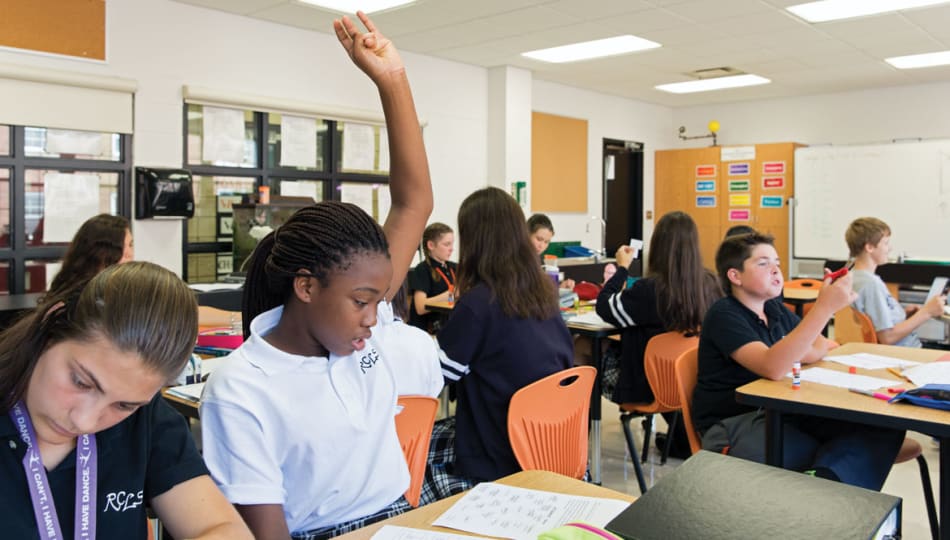
Student population
The social organization of the school is based in the house system. Students, both boarding and day, are assigned to one of 10 houses that correspond to the campus residences.
“There is a strong familial culture,” one parent commented to us, “that embraces and unites everyone, across the many, many diverse cultures and countries that make up the student body.” The student population is predominantly boarding, something that provides the basis for the culture of the school. This is a boarding school with day options, rather than the other way around. Even the day students feel that the campus is a home away from home, and many linger there after school, into the evenings, and attend programs on the weekends. Saturdays are particularly busy, with house events, a speaker series, and a community life program in addition to athletics and some down time.
The boarding environment, set apart from the world outside the campus, grants a sense of place that many alumni recall most about their student experience. “I belonged,” Peter Gzowski wrote. “I was part of something in a way I have seldom been since.” The students who attend enter a community where their perspectives and talents are shared and encouraged, and where they find belonging and empowerment. And Ridley is arguably better able to achieve those goals now than at any point in its history. With the growth in information and instructional technology, and the ease of international travel, the school has resources, students, and staffing that support the overall mandate in ways that weren’t available a century or even just a few decades ago.
All houses include both day and boarding students, and day students sign in to their houses when they arrive each morning. They also have desks and lockers there, and make use of the common areas.
In the 2018–19 school year, there are students from more than 60 countries. Flags of student home countries are hung prominently from the side walls of the Great Hall, a long-standing tradition at the school. That said, the countries represented in the student population have surpassed the number of flag standards available, creating the need to rotate the flags throughout the school year so that all are flown there, at least for a time.
Students really take all of that to heart. The prefect homily given during chapel on the day we visited was on the topic of home. The speaker’s grandparents, immigrants from Europe, were present that day, and he took that as a starting point—the idea that we move around, but we take our homes with us. It was an example of something that the students often voice and celebrate in various ways, and they seem to genuinely feel like citizens of the world participating within a globally minded community.
Summer camps and residential programs
More than 1,800 youth enrol each summer in the Ridley day and summer programs, so the camps have a population which is more than double the student population on campus during the school year.
The main reason the camps are so popular is because they are so well run, but there are lots of other great things about the camps as well. The proximity to Niagara Falls and Toronto is certainly an attractive factor. The campus is frankly gorgeous, with a wealth of green space. The facilities, too, are top-notch, including outdoor ed equipment, two professional-level performing arts spaces, and plenty of resources. The camps make extensive use of all of it.
The symphony sessions—there’s one for young musicians who compete for spots, another for tyros—are staffed by members of the Niagara Symphony Orchestra. They’re the only true symphony camps of their kind in the country.
The English as an Additional Language (EAL) camps are some of the best in the region and beyond. The EAL sessions provide international students with a strong camp experience, a residence with peers from around the world, and an intensive language immersion and instruction program.
Other offerings range across a fairly wide swath of interests, including those that appeal to international students, to those programmed with local kids in mind. It’s a great mix, and even though kids are in different sessions, many of them are run consecutively, allowing a nice interaction between young people of like interests as well as those with divergent ones.
Athletics
“My daughter loves the traditions of the school,” one parent told us, “like cadets and chapel. She also likes the focus on sport, and feels there is a very healthy emphasis on extracurricular activities—transforming most kids into ‘all-rounders.’”
Jay Tredway, director of athletics, likes to say that Ridley is “the most active campus in Canada.” That might be hard to prove, though the dedication to physical activity, both recreationally and competitively, is considerable.
The school maintains a Long-Term Athlete Development (LTAD) plan—evident in the Lower School playscape—which is aimed at administering physical literacy from the younger grades through the secondary years. All students participate in physical activity daily.
Beginning in the 2017–18 school year, chapel was moved to the afternoon in order to open up time in the mornings for physical activity. The change was informed by a growing understanding of the relationship between physical activity and learning, as well as the results of an audit of the school’s activity programs and their effectiveness in 2014, in consort with the launch of the strategic plan. Previously, all students were required to engage in athletics a few times a week, though the schedule change brought that mandate forward. “If you want the kid to get the biggest bang for their physical activity buck, they need to be doing it before school starts,” says Tredway. “Those effects last essentially through the day if you’re doing it in the morning.” He adds: “Just going for a brisk walk before school starts can make a huge difference in your awareness or recall and memory.”
Ridley is associated with rowing, and has had an ongoing rivalry with Brentwood College (though the real force of that rivalry is more historical than actual). In any case, Ridley has been rowing competitively for more than 50 years, participating in the Henley Royal Regatta (UK) and the Head of the Charles Regatta (Boston). And the Ontario Ergometer Championships have been hosted by the school every year for decades. It’s a great story: a program that began with one skull in 1966 has helped to define the sport nationally and produced 14 Olympians.
As strong as the rowing program is, the hockey program has an even longer tradition within school life. There has been a hockey program since the school was founded, conducted outdoors on Twelve Mile Creek during the early years. The First Boys hockey team is the oldest active team on campus, though the offering has grown over the years. Both boys and girls teams are coached by a dedicated staff and supported by therapy and conditioning programs. Given the strength of the coaching staff, Ridley attracts high-level athletes to its hockey program from across Canada and beyond.
Ridley is one of the four founding schools of the Conference of Independent Schools Athletics Association (CISAA). There are 38 schools participating in the conference today, and it serves as the primary outlet for Ridley’s competitive athletic program.
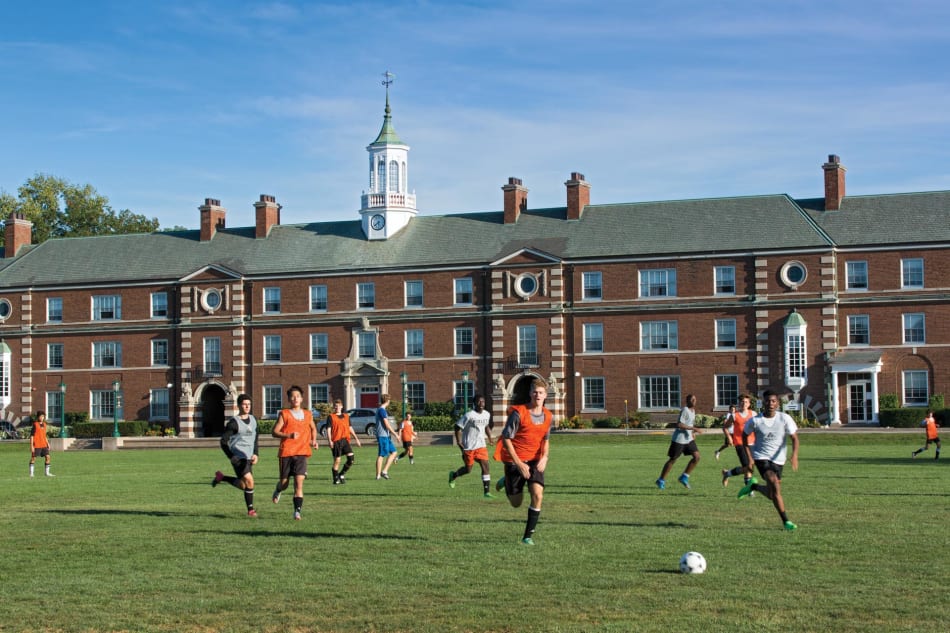
Pastoral care
Students meet with their advisors, in groups, every week. “We talk about goals, to academics, to courses. It’s basically just a nice place to sit down and talk things out,” says one student. There is a full health centre, which includes certified social-emotional counsellors. More generally, the school has made well-being and positive education initiatives a primary focus as part of the strategic plan launched in 2014. There are lots of strong examples of that vision in action.
To ease entry to the school each September, all the Grade 7 to Grade 12 students are taken to a camp in Muskoka for three days of team building, bonding, and the full range of camp activities. “We think you’re not ready to start learning if you’re homesick or if you don’t know anybody and you feel disconnected,” says Kidd. “Kids come back from camp and they feel like they have a friend; they feel like they’re part of it.”
In 2017, Ridley partnered with Dr. Lea Waters of the University of Melbourne, Australia, to become the first Visible Wellbeing foundational school in North America. Says Bett, “We believe a child’s physical and emotional, psychological well-being will underpin everything they do—not just in school, but beyond school.” That, in a nutshell, is the guiding principle of Visible Wellbeing—to ensure, through evidence-based practice, that academics sit within a program of well-being. The fact that they’ve partnered with Waters, and adopted her model, is a strong expression of how seriously the school is taking student wellness.
“I feel very comfortable,” says a parent of a boy who arrived as a boarder for Grade 11. “Very reassured and secure. Because when you’re letting your 16-year-old leave home, there are worries. But everybody there has been very embracing. It’s been good for me to know that he’s been well taken care of. … They are in tune with the kids and, because it’s a small group, everybody knows everybody.”
“We know that students, as part of their development, will make mistakes,” says Lance Postma, dean of student life. “They’re adolescents, and we have a level of tolerance for mistakes that students will make.”
Postma says that behaviours that contravene the ethos of the school are dealt with swiftly, directly, and empathetically. The approach to discipline isn’t meant to be punitive, but rather to enable students to find a workable path away from those behaviour patterns. Postma says of the testing program. “If they’re in a situation and they’re tempted—perhaps their friends know about it—they can say, ‘listen, I can’t. I value my relationship with the school.’”
Moments of weakness are seen as the beginning of a conversation around the challenges young people face and social fallouts associated with them. That said, as with any school, there are some behaviours for which there are no second chances, namely those that put others at risk of physical or mental harm. Harmful behaviours, rightly, are seen for what they are; and the safety of others is, understandably, the guiding principle for action taken.
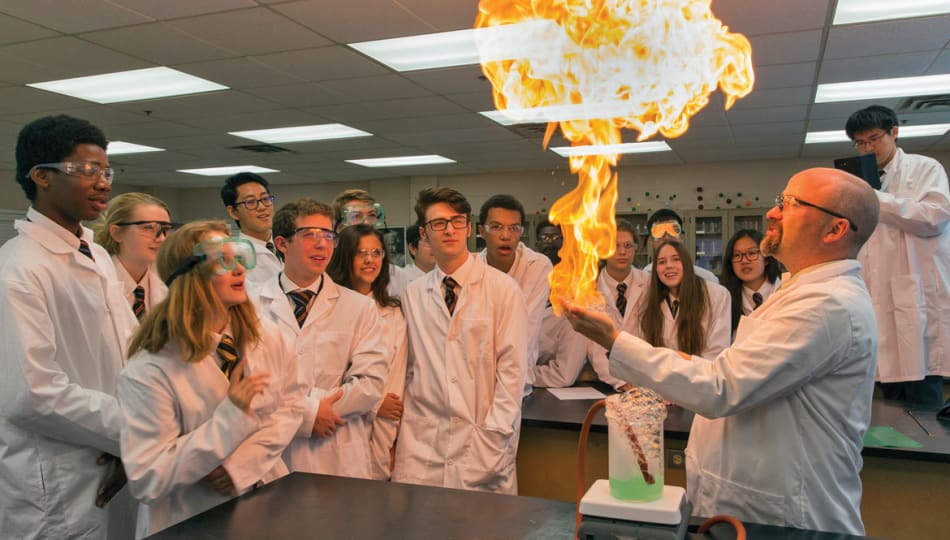
Getting in
Admission is rolling, meaning that students are able to enter the program in any year. That said, the application process is protracted, and it’s best to start as early as possible. The school intends to make sure that all students enrolled are the right fit for the school, and the process is undertaken in that vein.
The school isn’t going to make any snap decisions, and they expect that families won’t either. “Everyone goes through a process,” says Julie Cameron, director of admissions. “It’s not just an application.” She describes successful applicants as “mission serviceable”—a slight but telling adjustment of “mission appropriate,” a term used more commonly in private schooling. It’s a subtle shift, to be sure, though it seems intended to underscore the reciprocal, ongoing relationship between a student and the school. In any case, grades and letters of reference aren’t enough, and they are not necessarily the top criteria for admittance.
Applicants are encouraged to complete a Character Skills Snapshot (CSS), which is quite a nice piece of the application package. The best schools aren’t just looking to enroll students; rather, they’re looking to enroll students who share the outlook and values of the school, and whose talents and personality will mesh well with the student culture. The interview process is a primary means of assessing all of that, and the CSS further underscores a dedication to ensuring social as well as academic fit.
Equally important, if not more so, is that the school takes pains to ensure that every student who attends truly wants to be there. All applicants are interviewed with their parents in the room as well as in isolation from them. Cameron explains that interviews can range anywhere from 30 minutes up to an hour, which is a time to engage in a conversation, rather than work through a roster of content-based questions. Sometimes the family and the student will be called in for a second interview, which should also be seen for what it is: due diligence undertaken with the best interests of all parties in mind. Students are encouraged to spend a day on campus, attending classes and daily routines with their potential classmates. They also tour with admissions ambassadors, students who volunteer to provide campus tours to visitors.
The admissions team is larger than you’d find at many schools, with officers specializing in specific geographical areas of the world. The intention is to ensure that students are seen in context by someone who is conversant with their culture. Ridley’s admissions officers become specialized in those areas, confident in the knowledge that they are comparing apples to apples. “For example,” says Cameron, “you know what a German student’s report card looks like.” It’s a nice attention to detail, one that Ridley is able to offer in part because of the size of the school—having a larger student body requires a larger admissions staff, and therefore an ability to specialize more than other schools might. It’s also indicative of the level of attention the school puts on managing the international aspect of the school community.
Also telling is that Cameron comes to Ridley from a career in customer service. The school administration sees their relationship with families in that light, which isn’t necessarily true at all schools, and it’s something families regularly comment favorably upon.
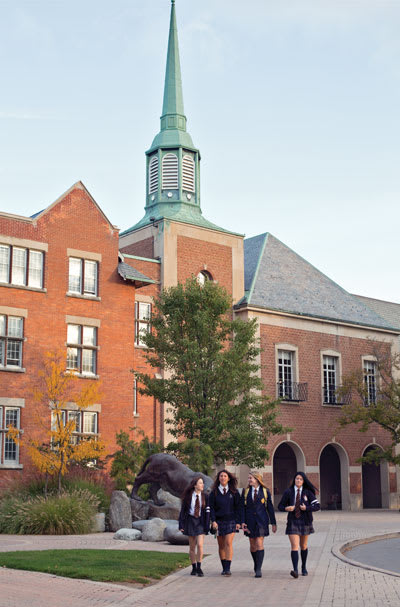
Money matters
The list of incidentals not included in tuition is fairly standard. Lower School after care and busing are available, though not included with tuition. However, meals are included within tuition for both day and boarding students. For the most part, parents have told us that there were few surprises throughout, the one exception being that, if a student wishes to engage an external tutor, there is a fee applied for that.
Ridley directs in excess of $2.5 million into scholarships and tuition assistance every year, funds provided to the school through philanthropy. Wendy Darby, Ridley graduate and archivist, had arrived in Grade 5. “I was a St. Catharines girl, and I was on tuition assistance. I worked and paid partially myself. And that’s what I’d say up front: it doesn’t mean that I’m well off; it means that my parents believe in education and they believed in sending me to the best place that they could, with some assistance. And I’m so grateful for it. I understood what opportunities it would open up for me.”
The intention of the tuition assistance program is to promote diversity within the student body and to ensure that all students who should attend are able to. Thirty percent of the Ridley student body receives some form of tuition assistance, as distributed through bursaries and merit-based scholarships. There are some scholarships for the summer programs as well, intended to provide opportunities for kids, to grow the diversity within those programs, and to help create a more porous interface between the school and the surrounding community.
Alumni
As a function of the school’s age, size, and mandate, Ridley has a sizable alumni network, both in Canada and beyond. There are in excess of 8,000 alumni around the world. Many retain a connection to the school, and the homecoming event has an attendance of more than 500 each year. Once referred to as “Old Boys,” the now-coed alumni identify as “Old Ridleans” or “ORs,” something that many do with demonstrable pride.
The presence of a sizable and active alumni is a great asset to the school, one that helps drive the culture of the institution, while also creating connections for graduating students throughout the world. It also confers a sense of belonging and participation within something bigger, more far reaching. It’s a significant piece of the Ridley, nicely in evidence throughout the campus and in a full calendar of annual events.
The alumni network is serviced actively by the school’s development office, which hosts 30 events around the world annually. Most are casual affairs to keep alumni engaged in the ongoing life of the college. As at any school, there’s a fundraising aspect to these events, though it’s clear that that function isn’t the only, or even the primary, impetus. The school sees the tradition that the alumni represent as one of its assets, one that enriches the life of the school and the learning experience it’s able to offer. There are names and dates carved into the backs of the chairs in the dining hall, and while those are to commemorate donors, they also give a sense of the long life of the school. They’re reminders of all the various people who have not only come through the doors, but have also sat in these chairs, and to some extent, think of Ridley as a kind of home.
An example is a documentary that was produced in 2017, Ridley Carries On. The school visited eight alumni in the UK who had been sent to Ridley at the outset of World War II. Not all alumni stories are writ as large as that, though the school sees all of them as holders of the school’s story. In the last few years, there’s been a renewed effort to bring more of those stories forward, in particular those of the female alumni. A book published in 2014, 40 Years of Women at Ridley, provides an insightful history, as well as an informal foundational document for ongoing efforts to create a more overt gender parity within the culture and the life of the school.
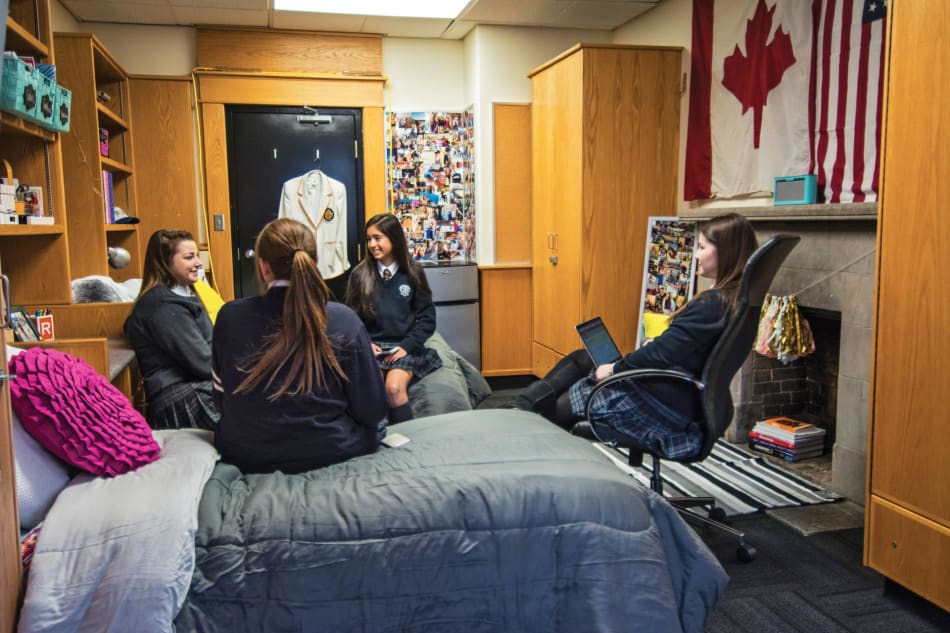
The takeaway
Ridley College expresses so many of the great traditions of private school, and it comes by all of them absolutely honestly. The school was founded in 1889, making it one of the oldest schools in the country. It began life as an Anglican boys’ school—it was named after an Anglican bishop—but is non-denominational today, and has been coed since 1973. That said, many of the traditions that inform the life of the school date back to its founding, including chapel meetings that serve to bring the school together around shared events and values. The school maintains a cadet corps, the largest of its kind in Canada. The chapel, and indeed all of the buildings that comprise the campus, are, frankly, gorgeous. It’s easily one of the most beautiful campuses in the country. The strategic plan, implemented in 2014, provided an opportunity to take stock of the school at the time of its 125th anniversary, including a dedication to maintaining a global perspective across the breadth of the curriculum. Throughout its long history, Ridley has maintained a reputation as one of the best schools in Canada, one that no doubt will remain for very many years to come.
One parent noted to us that “I think the school knows where it can grow, and is heading there.” That’s important too, indicating a willingness to consistently consider and reconsider best practices in light of the evolving needs of the new generations of students that enter. Leadership is clearly keen to allow faculty to follow their professional interests—the trip to the US to investigate the KIBO program is a nice example, among many—again allotting the necessary resources to realize the full force of that commitment to program development.
What families typically find on entering the school, even just for a visit, is that there’s also an unexpected playfulness within the environment. We maybe forget that, after all, this is a place designed to help children grow into a sense of their talents and abilities, and to help them find their voices and their places in the world. It’s a place for kids. The programs are varied, often building on the energies and curiosities of the kids themselves.
Ultimately, this is a new school as well as an old one; one not keen to rest on its laurels. For students, Ridley provides a consistent, tangible sense of community. And, often, it’s the support of that community that they attribute their success to—in secondary, post-secondary, and beyond.
